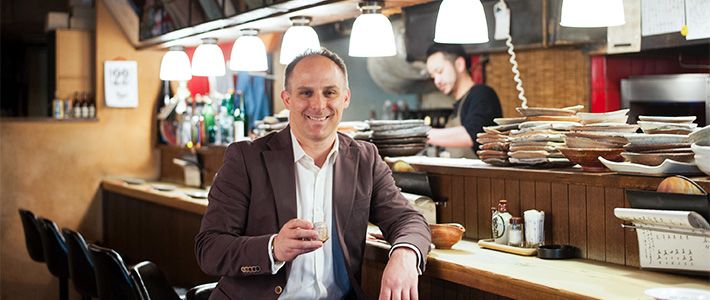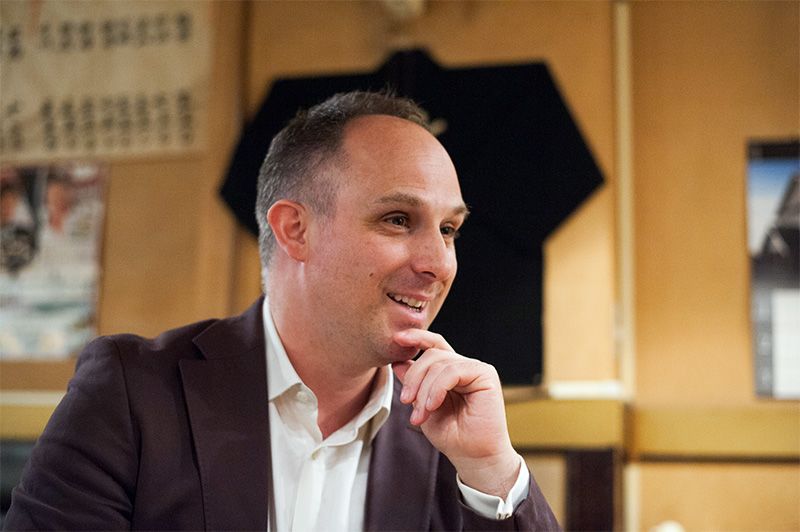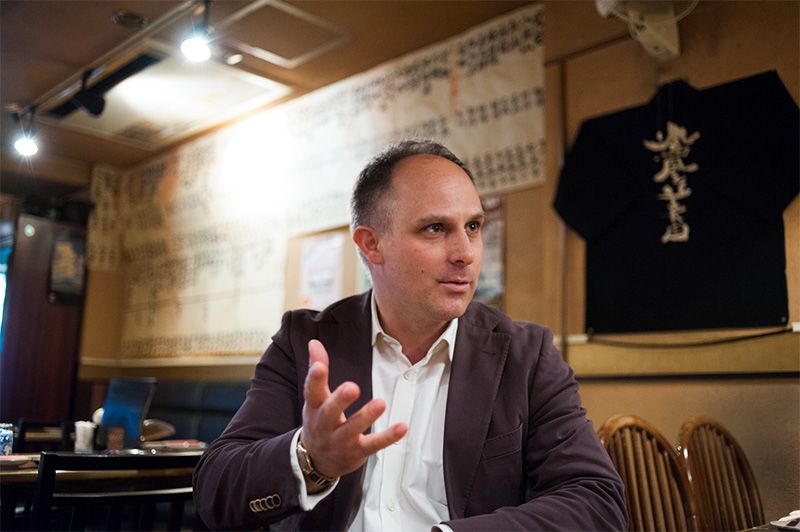
Exploring Japan Bite by Bite: Food Writer Michael Booth
Guideto Japan
Lifestyle Culture- English
- 日本語
- 简体字
- 繁體字
- Français
- Español
- العربية
- Русский
First published in 2010 in English, Michael Booth’s Sushi and Beyond: What the Japanese Know About Cooking became a bestseller in Japan following its translation in two volumes in 2013 and 2014. The travelogue focuses on Booth’s journeys through Japan with his wife and two young sons. It struck a chord among Japanese readers and was later turned into both a manga series and an anime, which has been featured on NHK’s domestic and international services as well as on Netflix Japan. He sat down with us at an izakaya pub in Tokyo’s Akasaka and described how he got to know Japan through its food.
A Love of Food and Travel in Japan
INTERVIEWER What was a particularly memorable experience when you were researching Sushi and Beyond?
BOOTH Lunch with sumō wrestlers was pretty incredible. What was great about traveling with kids was seeing the world through their eyes, first of all, and second, having the world react to you differently because you’re with little ones. Seeing a rikishi playing with my kids in the sumō stable was unforgettable. And having lunch with them was fascinating: seeing what they eat, chanko-nabe stew, and spam. It was surprisingly healthy food, but in vast quantities.
INTERVIEWER What was the most memorable, exotic dish during that trip?
BOOTH I remember we went to Okinawa at the end of the journey and I got to try the seaweed called umibudō, or “sea grapes,” for the first time. That was mind-blowing. It’s stayed with me all these years and I’ve kept wanting to learn more. I’ve just finished another book where we did the same journey, but in the other direction. I went back and investigated umibudō—where it’s grown, and so on. Yuba tofu skin is also an amazing, unique food product that I love. And of course I loved miso, sake, and katsuobushi bonito flakes. I also tried the bones of the unagi, or eel.
INTERVIEWER You tried everything.
BOOTH Well, there were some things that I’d rather not have a second time. I’ve kept trying with nattō [fermented soybeans], but I’m not there yet in terms of liking it. Nor with yamaimo [grated mountain yam] and mozuku [slimy seaweed].
INTERVIEWER Are there any particular chefs you’ve come to admire from your journeys?
BOOTH I was lucky enough to go to Sushi Jirō in Tokyo’s Ginza. Unfortunately, it was the best sushi I’ve ever had. It’s ridiculously expensive and impossible to get a reservation there, but it was amazing. Jirō was very severe when he was making the sushi, no talking, but afterward he was very friendly and chatty. It was the most delicious sushi. He ages the fish so expertly. It has this incredible umami flavor and richness, but he counters it with a heavily vinegared rice, which I love. I didn’t expect the combination to be so punchy. It was one of my top meals in Japan.
Writing to Cuisine, and Back to Writing Again
INTERVIEWER How did you first become a writer?
BOOTH After doing a degree in English literature I went to work in television, but I hated it and ran away to Bangkok, where I began writing for an English-language magazine. I eventually went back to England and did a postgraduate course in journalism, after which I freelanced. When I met my Danish wife, she kind of dragged me to live in Copenhagen, and one of the first jobs I got was writing the Time Out guide to the city—I did the restaurant section. I realized I didn’t know much about food, and I couldn’t really criticize or write about chefs without knowing what I was doing. That’s what led me to go to Paris to train to be a chef.
INTERVIEWER Do you still cook? Do you make any Japanese food at home in Copenhagen?
BOOTH Not that I make Japanese dishes, but I do use some Japanese ingredients. I use miso as a marinade for chicken, or put it into a stew. I also use sake and mirin for a marinade with garlic, ginger, and soy sauce. I love fresh wasabi on carpaccio and yuzu is fantastic with chocolate. Parmesan cheese, sesame seeds, and ponzu make everything taste good. I could put these on my shoe and eat it!
INTERVIEWER How have Japanese readers and viewers been reacting to Sushi and Beyond?
BOOTH I didn’t write at all with Japanese people in mind. It was written to explain Japanese food beyond sushi, as the title suggests, to Brits and Americans. A publisher picked it up about three years after it was published in Britain, which was a big surprise. I thought it might have a small print run, but it sold really well in Japan. I was incredibly grateful and surprised.
Then, out of the blue, I got this email from the NHK animation department saying they were interested. The producers came to visit me in Denmark to persuade me of their seriousness. While the cartoon series is fiction and they turn up the fictional element quite a bit—there are eight-meter-high “gothic lolita” characters in it—but it was a big success on NHK and on Netflix. It’s been a weird roller coaster of unpredictable success.
One of the Great World Cuisines
INTERVIEWER Tell me about your latest journey to Japan.
BOOTH My upcoming book is called The Meaning of Rice, and it’s another journey, with about thirty or thirty-five food stories that we found along the way. It’s everything from insect cuisine in Nagano to going out with fishermen in Hokkaidō for uni [sea urchin], and found the best dried seaweed in Japan, called Asakusa nori . . . I was also a judge at the World Sushi Cup in Tokyo, which was a strange experience. I even met an amazing one-armed ramen chef. He lost his arm in a dough-churning machine while making ramen.
INTERVIEWER With all these experiences in Japan, what’s your favorite food here?
BOOTH Living in Europe, it’s always the things I can’t get there. Things like tofu and yuba. It’s the bits of fish that you can’t get where I live, like ankimo [monkfish liver] or shirako [milt of cod and other fish]. The types and quality of fish. I had some sashimi in Osaka last week that was so flavorful. I had an amazing steamed tilefish nigiri two nights ago that was just mindblowing! Where I live, though, it’s cod and farmed salmon.
INTERVIEWER What about low-end versus high-end food? Food stalls versus pricy kaiseki meals?
BOOTH Izakaya are my ideal place to eat. I love the quality, variety, and seasonality of the ingredients, along with the imagination of the chefs, who are always putting together things you’ve not seen before. I always get a higher experience than I’ve previously had.
INTERVIEWER How does Japan rank in your palette of world cuisine?
BOOTH I think there are five great world cuisines: Mexican, Chinese, French, Italian, and Japanese. Japanese is my favorite. I love French cuisine—I trained as a chef at Cordon Bleu in Paris for a year, so I have huge respect for French. But Japanese has this amazing diversity—regional and seasonal diversity—and awareness of it to match. I’ve already written two books about Japan, and I could easily write another three books and not cover the same ground twice. I’ve just been to Ōita Prefecture for the first time. Great food—amazing fugu blowfish and onsen tamago, the eggs boiled in hot springs, as well! I’m always trying to encourage people to venture farther afield when they come here. Of course, Tokyo is amazing and you can have a great time here along. But I’m kind of evangelical about getting out of it and going to other places in Japan.
 In front of menu on the wall at Marushige in Akasaka, Tokyo.
In front of menu on the wall at Marushige in Akasaka, Tokyo.
Advice for the Hungry Traveler
INTERVIEWER What are your top three tips for foodies visiting Japan?
BOOTH Get the Google Translate app, so you can come to places like this izakaya and just point at the menu. It sounds trivial, but these places are so daunting for foreigners because there’s no English. Otherwise you have to do the embarrassing thing—pointing at other people’s food, saying you’ll have what they have. Also, you should get a portable wi-fi router so you can be online all the time. You can walk down any street and know what they serve—that’s going to change everything.
INTERVIEWER You grounded yourself in a book by the cuisine expert Tsuji Shizuo before you came to Japan. Do you think foodies should study Japanese food before they visit?
BOOTH This isn’t a school trip, so no, I don’t think they need to delve into it. Maybe read some articles online, check out some blogs, and see what’s happening. I don’t think they have to study it like I have. But buy my book, of course!
(Banner photo: Michael Booth enjoys a cup at the izakaya Marushige in Akasaka, Tokyo. Interview by Tim Hornyak. Photos by Motono Katsuyoshi.)

